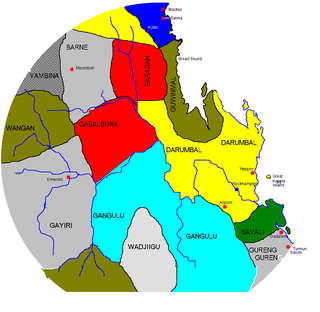The Bakanambia, also known as the Wanbara, are an Aboriginal group of Australia. Traditionally, the Bakanambia lived in the vicinity of Princess Charlotte Bay in the state of Queensland. One of the ethnonyms applied to them was Lama Lama, which is now used of a larger aggregation of remnants of several tribes.

The Kangulu, also written Gangulu, is an aboriginal tribe from the Mount Morgan area in Queensland, Australia.
The Badjiri or Budjari, also written Badyidi, are an Australian Aboriginal people group of Queensland. They are not to be confused with the Pitjara.
The Wangan are an indigenous Australia people of the Isaac Region of Central Queensland. There is no linguistic data.
The Tulua were an indigenous Australian tribe of Queensland.
The Kuungkari are an indigenous Australian people of Queensland. They are to be distinguished from the Kunggari.
The Wadja were an indigenous Australian people of Queensland.
The Wakabunga are an indigenous Australian people of the state of Queensland.
The Barada were an indigenous Australian people of Central Queensland.
The Kwiambal were an indigenous Australian people of New South Wales.
The Warakamai, now more frequently known as the Warrgamay, are an indigenous Australian people of the state of Queensland.
The Kairi (Gayiri) were an indigenous Australian people of the state of Queensland.
The Wanamara (Wunumara) were an indigenous Australian people of the state of Queensland.
The Yilba, also written Ilba, were an indigenous Australian people of the state of Queensland.
The Yangga were an indigenous Australian people of the state of Queensland. They are not to be confused with the Yangaa.
The Yambina were an indigenous Australian people of the state of Queensland.
The Yungkurara were an indigenous Australian people of the state of Queensland.
The Karingbal (Garaynbal) are an indigenous Australian people of the state of Queensland. They spoke a dialect of Biri.
The Jeithi were an indigenous Australian people of the state of New South Wales.
The Kawambarai (Gawambaraay) were an indigenous Australian people of the state of New South Wales. Their domain was in the central–western district of New South Wales




